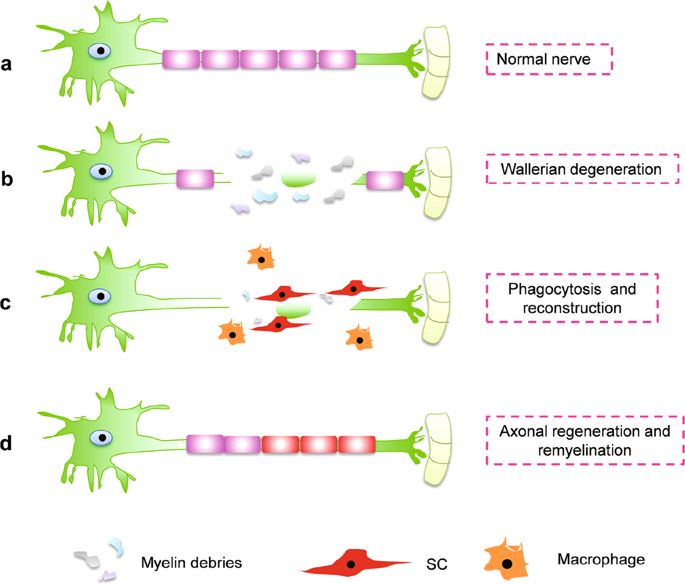当前位置:
X-MOL 学术
›
Acta Pharmacol. Sin.
›
论文详情
Our official English website, www.x-mol.net, welcomes your
feedback! (Note: you will need to create a separate account there.)
Growth factors-based therapeutic strategies and their underlying signaling mechanisms for peripheral nerve regeneration.
Acta Pharmacologica Sinica ( IF 6.9 ) Pub Date : 2020-03-02 , DOI: 10.1038/s41401-019-0338-1 Rui Li 1, 2 , Duo-Hui Li 1 , Hong-Yu Zhang 1 , Jian Wang 3 , Xiao-Kun Li 1 , Jian Xiao 1, 3
Acta Pharmacologica Sinica ( IF 6.9 ) Pub Date : 2020-03-02 , DOI: 10.1038/s41401-019-0338-1 Rui Li 1, 2 , Duo-Hui Li 1 , Hong-Yu Zhang 1 , Jian Wang 3 , Xiao-Kun Li 1 , Jian Xiao 1, 3
Affiliation

|
Peripheral nerve injury (PNI), one of the most common concerns following trauma, can result in a significant loss of sensory or motor function. Restoration of the injured nerves requires a complex cellular and molecular response to rebuild the functional axons so that they can accurately connect with their original targets. However, there is no optimized therapy for complete recovery after PNI. Supplementation with exogenous growth factors (GFs) is an emerging and versatile therapeutic strategy for promoting nerve regeneration and functional recovery. GFs activate the downstream targets of various signaling cascades through binding with their corresponding receptors to exert their multiple effects on neurorestoration and tissue regeneration. However, the simple administration of GFs is insufficient for reconstructing PNI due to their short half‑life and rapid deactivation in body fluids. To overcome these shortcomings, several nerve conduits derived from biological tissue or synthetic materials have been developed. Their good biocompatibility and biofunctionality made them a suitable vehicle for the delivery of multiple GFs to support peripheral nerve regeneration. After repairing nerve defects, the controlled release of GFs from the conduit structures is able to continuously improve axonal regeneration and functional outcome. Thus, therapies with growth factor (GF) delivery systems have received increasing attention in recent years. Here, we mainly review the therapeutic capacity of GFs and their incorporation into nerve guides for repairing PNI. In addition, the possible receptors and signaling mechanisms of the GF family exerting their biological effects are also emphasized.
中文翻译:

基于生长因子的治疗策略及其周围神经再生的潜在信号机制。
周围神经损伤 (PNI) 是创伤后最常见的问题之一,可导致感觉或运动功能显着丧失。受损神经的恢复需要复杂的细胞和分子反应来重建功能轴突,以便它们能够准确地与原始目标连接。然而,PNI 后没有完全康复的最佳治疗方法。补充外源生长因子(GF)是一种新兴的多功能治疗策略,可促进神经再生和功能恢复。 GF通过与其相应受体结合激活各种信号级联的下游靶标,从而发挥对神经恢复和组织再生的多重作用。然而,由于 GF 的半衰期短且在体液中快速失活,简单施用 GF 不足以重建 PNI。为了克服这些缺点,已经开发了几种源自生物组织或合成材料的神经导管。它们良好的生物相容性和生物功能性使它们成为输送多种GF以支持周围神经再生的合适载体。修复神经缺陷后,从导管结构中受控释放 GF 能够持续改善轴突再生和功能结果。因此,近年来,生长因子(GF)递送系统的治疗受到越来越多的关注。在这里,我们主要回顾一下 GF 的治疗能力及其与神经导管修复 PNI 的结合。此外,还强调了GF家族发挥其生物学效应的可能受体和信号机制。
更新日期:2020-04-24
中文翻译:

基于生长因子的治疗策略及其周围神经再生的潜在信号机制。
周围神经损伤 (PNI) 是创伤后最常见的问题之一,可导致感觉或运动功能显着丧失。受损神经的恢复需要复杂的细胞和分子反应来重建功能轴突,以便它们能够准确地与原始目标连接。然而,PNI 后没有完全康复的最佳治疗方法。补充外源生长因子(GF)是一种新兴的多功能治疗策略,可促进神经再生和功能恢复。 GF通过与其相应受体结合激活各种信号级联的下游靶标,从而发挥对神经恢复和组织再生的多重作用。然而,由于 GF 的半衰期短且在体液中快速失活,简单施用 GF 不足以重建 PNI。为了克服这些缺点,已经开发了几种源自生物组织或合成材料的神经导管。它们良好的生物相容性和生物功能性使它们成为输送多种GF以支持周围神经再生的合适载体。修复神经缺陷后,从导管结构中受控释放 GF 能够持续改善轴突再生和功能结果。因此,近年来,生长因子(GF)递送系统的治疗受到越来越多的关注。在这里,我们主要回顾一下 GF 的治疗能力及其与神经导管修复 PNI 的结合。此外,还强调了GF家族发挥其生物学效应的可能受体和信号机制。











































 京公网安备 11010802027423号
京公网安备 11010802027423号